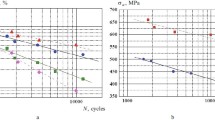Abstract
The relationships between microstructure and fatigue crack propagation behavior were studied in a 5Mo-0.3C steel. Microstructural differences were achieved by varying the tempering treatment. The amounts, distribution, and types of carbides present were influenced by the tempering temperature. Optical metallography and transmission electron microscopy were used to characterize the microstructures. Fatigue fracture surfaces were studied by scanning electron microscopy. For each heat treatment the fatigue crack growth properties were measured under plane strain conditions using a compact tension fracture toughness specimen. The properties were reported using the empirical relation of Paris [da/dN = CoΔKm]. It was found that secondary hardening did influence the fatigue crack growth rates. In particular, intergranular modes of fracture during fatigue led to exaggerated fatigue crack growth rates for the tempering treatment producing peak hardness. Limited testing in a dry argon atmosphere showed that the sensitivity of fatigue crack growth rates to environment changed with heat treatment.
Similar content being viewed by others
References
P. Paris and F. Erdogan:Trans. ASME, 1963, vol. 85, pp. 528–34.
H. H. Johnson and P. C. Paris:Eng. Fract. Mech., 1968, vol. 1, pp. 3–45.
G. R. Chanani, S. D. Antolovich, and W. W. Gerberich:Met. Trans., 1972, vol. 3, pp. 2661–72.
W. G. Clark, Jr.:Eng. Fract. Mech., 1968, vol. 1, pp. 385–98.
N. E. Frost, L. P. Pook, and K. Denton:Eng. Fract. Mech., 1971, vol. 3, pp. 109–26.
C. E. Richards and T. C. Lindley:Eng. Fract. Mech., 1972, vol. 4, pp. 951–78.
P. R. Evans, N. B. Owens, and B. E. Hopkins:Eng. Fract. Mech., 1971, vol. 3, pp. 463–73.
R. P. Wei, P. M. Talda, and C. Li:Fatigue Crack Propagation, ASTM, STP 415, pp. 460–80, ASTM, Philadelphia, Pa., 1967.
F. A. Hieser and W. Mortimer:Met. Trans., 1972, vol. 3, pp. 2119–23.
G. A. Miller:Trans. ASM, 1968, vol. 61, pp. 442–48.
A. A. Anctil and E. B. Kula:Effects of Environment and Complex Load History and Fatigue Life, ASTM, STP 462, pp. 297–317, ASTM, Philadelphia, Pa., 1970.
R. D. Goolsby: Ph.D. Thesis, University of California, Bekeley, LBL-405, Nov. 1971.
1973 Annual Book of ASTM Standards, part 31, p. 960, ASTM, Pa., 1973.
J. Mandel:The Statistical Analysis of Experimental Data, pp. 247–50, Wiley-Interscience, New York, 1964.
P. M. Kelly and J. Nutting:J.Iron Steel Inst., 1961,vol. 197,pp. 199–211.
J. F. Throop and G. A. Miller:Achievement of High Fatigue Resistance in Metals and Alloys, ASTM STP 467, pp. 154–68, ASTM, Philadelphia, Pa., 1970.
C. D. Beachem and R. M. N. Pelloux:Fracture Toughness Testing and Its Applications, ASTM STP 381, pp. 210–45, ASTM, Philadelphia, Pa., 1965.
E. B. Kula and A. A. Anctil:J. Mater., 1969, vol. 4, pp. 817–41.
T. B. Cox and J. R. Low, Jr.:Met. Trans., 1974, vol. 5, pp. 1457–70.
B. S. Lenient, B. L. Averbach, and M. Cohen:Trans. Amer. Soc. Metals, 1954, vol. 46, pp. 851–81.
Y. H. Liu:Trans. Amer. Soc. Metals, 1969, vol. 62, pp. 55–63.
C. Laird:Fatigue Crack Propagation, ASTM, STP 415, pp. 131–80, ASTM, Philadelphia, Pa., 1967.
R. M. N. Pelloux:Trans. Amer. Soc. Metals, 1964, vol. 57, p. 511–18.
L. H. Classman and A. J. McEvily, Jr.: NASA TN D-928, 1962.
R. O. Ritchie and J. F. Knott:Acta Met, 1973, vol. 21, pp. 639–48.
D. Raynor, J. A. Whiteman, and R. W. K. Honeycombe:J. Iron Steel Inst., 1966, vol. 204, pp. 349–54.
J. R. Low, Jr.:Trans. TMS-AIME, 1969, vol. 245, pp. 2481–94.
J. Plateau, G. Henry, and C. Crussard:Rev. Met., 1957, vol. 54, pp. 200–16.
E. P. Dahlberg:Trans. Amer. Soc. Metals, 1965, vol. 58, pp. 46–53.
Author information
Authors and Affiliations
Rights and permissions
About this article
Cite this article
Horn, R.M. Influence of heat treatment on the fatigue crack growth rates of a secondary hardening steel. Metall Trans A 6, 1525 (1975). https://doi.org/10.1007/BF02641963
Received:
DOI: https://doi.org/10.1007/BF02641963




